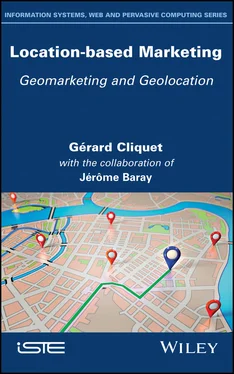1.3. Spatial marketing and geomarketing applications
The applications of spatial marketing and geomarketing concern both practitioners and researchers. However, it must be noted that, while practitioners have been able to use geomarketing tools to identify sites where to set up points of sale, broadcast an advertising campaign in the regions or practice direct marketing (Ozimec et al . 2010), they suffer from a lack of conceptual models allowing them to better interpret the data. However, it must be admitted that the number of scientific publications in spatial marketing, except those concerning location issues, is limited to say the least.
The beginning of the new millennium was approached like the beginning of the digital age. But we could already regret the “tide” of advertisements received by everyone without too much differentiation (Preston 2000): the spam emails we all receive every day show that 20 years later, things have not really changed. The customer orientation of European distribution companies seems insufficient despite the amount of local information they have in their possession thanks to loyalty cards (Ziliani and Bellini 2004). The mass of data resulting from these cards should make it possible to identify consumers’ needs and desires and thus to offer them appropriate promotional offers: this is one of the purposes of Big Data (Nguyen and Cao 2015) which constitute one of the major challenges of the now-joint research, on the one hand, in marketing, and on the other hand, in management of information systems (Goes 2014).
1.3.1. Applications in retail and mass distribution
Retailing was among the first sectors to be interested in geomarketing techniques. The applications focus on problems related to the analysis of trading areas and the location of points of sale. As far as trading areas are concerned, professional methods were once often based on the determination of primary, secondary and tertiary (or marginal) areas, known as the analog method (Applebaum 1966). This more or less circular representation around the point of sale has been called into question with the appearance of geomarketing software and the possibility of geolocating store customers from their addresses obtained by questioning the customer at the checkout and then thanks to loyalty cards now dematerialized in most stores. The trading areas of the stores no longer have anything to do with concentric circles: we are in fact dealing with “archipelagos” (Viard 1994).
Concerning location problems, articles in scientific journals were mainly published in the 1980s (Ghosh and McLafferty 1982; Ghosh and Craig 1983; Ghosh 1984; Ghosh 1986; Ghosh and Craig 1986; Ghosh and Craig 1991) and based on location models, such as MCI (Multiplicative Competitive Interaction) (Nakanishi and Cooper 1974), useful both for understanding consumer spatial behavior (see Chapter 2) and georetailing with point of sale location (see Chapter 4).
1.3.2. Applications in services
Banks were the first service companies to take an interest in geomarketing in order to better understand the trading areas of their branches and to refine their location decisions. Hotels and restaurants are also aware of this, at least the largest companies. These two sectors offer an originality in terms of attracting customers: while restaurants attract both local and visiting customers, hotels only receive visiting customers. The gravity or polar side of the attraction, as found in most retail outlets, is therefore much less prominent than the so-called transient attraction (Cliquet 1997a).
1.3.3. Applications in marketing and utility management
Public marketing, or rather the marketing of public services, is developing more as a growing number of these services have become fee based. It is therefore now necessary to attract customers in order to make these services profitable or at least to reduce their costs. It has been possible to apply geomarketing as a territorial information system for Italian public administrations (e.g. Amaduzzi 2011). A methodology using spatial models has been developed to optimize the maternity network in France (Baray and Cliquet, 2013). The development of territorial marketing is inspired by a spatial marketing approach without always relying on geomarketing in the traditional sense of the term, namely with the use of software, but increasingly on smartphones applications (apps) (Barabel et al . 2010). In the health sector, the cost/proximity dilemma leads to an attempt to optimize the location of health services. Two applications have been published in the United States to make these services more geographically efficient. One of them proposes to redefine the regions of this country in order to improve the efficiency of liver transplantation (Kong et al . 2010): the size of the country, the rapid deterioration of transplants and the crucial lack of donors require such a redefinition.
1.3.4. Other applications
Tourism is obviously a very suitable receptacle for the application of spatial marketing. However, only organizational issues such as those of companies seeking to promote their tourism services and local authorities wishing to attract tourists, and not tourism as a general activity, will be addressed. Many cities now want to interest potential customers by offering them websites (Parker 2007) and even map-based apps designed to admire the beauty of the sites offered, thus developing mobile or m-tourism (Bourliataux-Lajoinie and Rivière 2013).
Geomarketing has also been used to explain the strategies implemented by French basketball clubs (Durand et al . 2005). Many other applications could be mentioned and we are probably only at the beginning of a new era in which space, thanks to technological aids, will no longer be a constraint either for humans or for organizations. For their part, geomarketing techniques could be of great help in better understanding the phenomena studied and in presenting the results well in order to facilitate their reading with the help of maps, which would give additional credibility. Some have understood the interest and do not hesitate to use maps to strengthen their demonstration, as was the case with the expansion of large networked companies (Laulajainen 1987).
1.4. Geomarketing, techniques and software
Certainly, without technical pretension, this book, which is more oriented towards decision making and strategy, must quickly review geomarketing techniques and the software available. Geomarketing techniques are based on GIS (Geographic Information Systems), in other words, the combination of geography and computer science to develop computer mapping. These digital geographic techniques are used by organizations in a wide variety of sectors. What was available through complex and often expensive software is now available on the Internet in the form of increasingly sophisticated websites as well as free and sometimes open-source software.
1.4.1. Uses of geomarketing software
The commercial location of stores, bank branches or other points of contact with customers was the first application of geomarketing with direct marketing. Geomarketing software is also used to measure the performance of points of sale within their trading area, to trace these trading areas in the form of isochrons, to study the socio-demographic characteristics, movements and behaviors of consumers, to monitor a delivery fleet or sales representatives’ tours, etc. They can also be used to set up points of sale within a network of retail or service points of sale, optimize these locations and evaluate their territorial coverage, etc. All these applications, whether they concern consumer spatial behavior, the marketing mix of companies or the georetailing of retail companies, not to mention mobile spatial marketing, will be covered in this book.
Читать дальше












